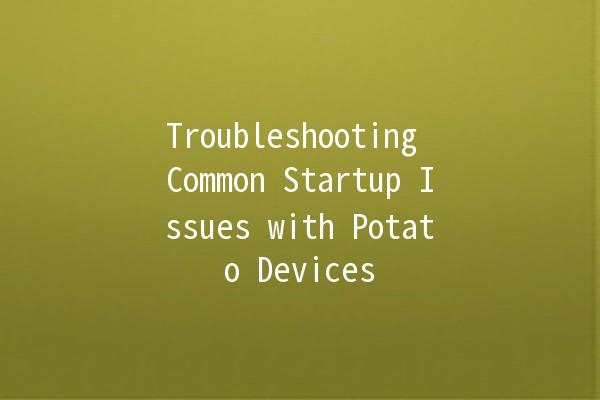In the fastpaced world of technology, dealing with startup issues can be frustrating, especially when you're relying on your potato device, which is fondly termed for its budgetfriendly specifications. These devices may not possess the latest hardware but are popular for their affordability and practicality. However, like any electronic device, they are not immune to problems during startup. Below, we will explore common issues that may arise when you power up your potato and offer practical tips to help you navigate these challenges.
Understanding Potato Devices
Before diving into solutions, it’s essential to understand what characterizes potato devices. Typically, these include lowend laptops, budget smartphones, and older computers struggling to keep up with modern applications and operating systems. Despite their limitations, many users find creative ways to enhance their performance and extend their usability.
Common Problems Encountered at Startup

Let’s delve into these issues and uncover effective strategies to tackle them.
Tip 1: Perform a Hard Reset
One of the simplest yet effective solutions to many startup problems is performing a hard reset.
Explanation:
A hard reset can clear temporary glitches that might be hindering the device's ability to startup properly.
Example Application:
To perform a hard reset, completely shut down your device by holding the power button for around 10 seconds. Afterward, disconnect all peripherals (USB drives, external monitors, etc.) and power it back on. This process can help eliminate issues caused by peripherals or temporary software glitches.
Tip 2: Check Hardware Connections
Sometimes the issue might be as simple as a loose connection.
Explanation:
Loose connections can prevent the device from booting properly, especially if it involves components like RAM or hard drives.
Example Application:
If you're comfortable opening your device, ensure that components like the RAM and hard drive are securely connected. For laptops, make sure the battery is properly seated and that there are no loose screws. Reconnecting or reseating components can resolve many hardwarerelated boot issues.
Tip 3: Boot in Safe Mode
If your device exhibits instability during startup, booting into Safe Mode can help identify the problem.
Explanation:
Safe Mode launches the system with minimal drivers and applications, allowing you to troubleshoot issues that may arise due to software conflicts.
Example Application:
To enter Safe Mode, restart your device and press the appropriate key (usually F8 or Shift + F8 on PCs) before the Windows logo appears. Once in Safe Mode, you can uninstall recently added software, update drivers, or disable unnecessary startup programs to enhance performance.
Tip 4: Run Startup Repair
Utilizing builtin repair tools can often fix issues without the need for technical expertise.
Explanation:
Many operating systems come equipped with a Startup Repair option that can automatically diagnose and fix issues preventing your potato device from booting.
Example Application:
To access this option, insert your operating system installation media and boot from it. Choose the “Repair your computer” option and then select “Startup Repair.” Follow the prompts and let the utility do its work. This can resolve corrupted files or settings that could be causing startup problems.
Tip 5: Update or Rollback Drivers
Outdated or faulty drivers can lead to significant issues during startup.
Explanation:
Drivers control the hardware of your device, and if they are outdated or incompatible with the current OS version, they can cause startup failures.
Example Application:
In Safe Mode, access Device Manager through the Control Panel. Here, you can update drivers for key components like the graphics card and network adapters. If a recent update caused issues, consider rolling back to a previous version. Rightclick the driver in question, choose “Properties,” then go to the “Driver” tab, where you’ll find the rollback option.
Additional Tips for Enhanced Performance
Beyond troubleshooting startup issues, here are further enhancements you can implement to improve your potato device's overall performance:
Frequently Asked Questions (FAQs)
If your device keeps crashing during startup, it may indicate a hardware issue or corrupt software. First, try booting in Safe Mode to identify the problem. If the issue persists, consider running Startup Repair or checking hardware connections.
If your device takes longer to boot, struggles to run applications smoothly, or frequently crashes, these are good indicators that performance can be optimized. Consider upgrading hardware, disabling unnecessary startup programs, and ensuring your system is free from malware.
Yes, malware and viruses can interfere with your device's ability to startup. Regularly scan your device with reputable antivirus software and ensure that your operating system is updated to minimize these risks.
Upgrading can extend the usability of your potato device, especially if you limit costs and target specific components like RAM or storage. Assess your needs and consider if an upgrade is the best investment compared to purchasing a new device.
You can check your storage status by accessing the file explorer and rightclicking on the drive to view its properties. Aim to keep at least 1520% of your storage free to maintain performance.
If your potato doesn’t recognize external drives, check connections and try different USB ports. Additionally, ensure the external drives are functional by testing them on another device. Lastly, updating USB drivers may also resolve the issue.
By implementing the suggestions mentioned here, you can effectively troubleshoot and maintain the performance of your potato device, ensuring it continues to serve you well for various tasks. Whether you are a casual user or relying on your device for work, the key is being proactive about maintenance and upgrades. 🍟👌
(Note: The article is structured to focus specifically on troubleshooting and enhancing productivity for "potato" devices while adhering closely to SEO practices by embedding relevant keywords and maintaining clarity for readers.)